 | |
| Genre | Role-playing game |
|---|---|
| Publisher | Judges Guild |
| Media type | |
Portals of Torsh is a supplement for fantasy role-playing games published by Judges Guild in 1980.
 | |
| Genre | Role-playing game |
|---|---|
| Publisher | Judges Guild |
| Media type | |
Portals of Torsh is a supplement for fantasy role-playing games published by Judges Guild in 1980.
Portals of Torsh is a campaign setting supplement intended for mid-level player characters, set in the prehistoric fantasy world of Torsh that uses magic portals for travel. The supplement provides a short summary of the world (along with wilderness encounters), along with detailed on a human town and a lizardman town, as well as a short scenario that takes place in the tower of a lizard-wizard. [1]
Portals of Torsh is a supplement that describes the small continent of Torsh which is mainly populated with lizard-men and prehistoric reptiles, with another plateau community populated by humans. The adventure includes encounters for dungeon, ruins, and wilderness environments. Teleportation portals, which were constructed by a lost race, have been scattered across the continent; one or more may be connected to the campaign world of the Dungeon Master to allow characters to travel to and from there. [2]
Portals of Torsh is a module approved for use with AD&D that presents a world in which is an ancient race built a series of portals to connect their world to other worlds before that race died out. The supplement lists the various types and specifics of the portals along with tables so more portals can be generated for use in a campaign. The adventure involves a human colony that lives on a plateau of another world. Only lizards evolved on the world of Torsh, so Lizardmen are the dominant species, and native plants are a poisonous to humans. One plateau was settled by a group of humans that fled through another portal has been made habitable for their descendants. [3]
Portals of Torsh was written by Rudy Kraft, with a cover by Jennell Jaquays [lower-alpha 1] , and was published by Judges Guild in 1980 as a 48-page book. [1]
Portals of Torsh is the first supplement released for the Portals series, depicting adventure sites which have been connected to each other through a series of interplanetary or interdimensional portals for teleportation. [4]
Aaron Allston reviewed the adventure in The Space Gamer No. 31. [2] He commented that "Anyone really interested in a pre-fab lizard-man continent may want to look at this one." [2] He stated that "This adventure has one advantage in that it is specifically designed to be accessible by any number of campaigns" because of the portals, but added that "logical access is not that big of a plus. The adventure is simply not very interesting. Characters can wander around wasting monsters, gathering loot, and gaining experience, all without having much fun." [2] Allston concluded his review by stating "Overall, this supplement will probably appeal only to those DMs who aren't imaginative enough to create something better." [2]
Portals of Torsh was reviewed in Dragon #44 (December 1980) by William Fawcett. He noted that the portals in the adventure were "interesting and bear an obvious resemblance to those of D.J. Cherryh and other science-fiction novels using a similar approach". [3] He commented that "Most of the module is based upon the interaction of the humans with the more numerous and physically stronger lizardmen. The slowly poisonous environment is a unique touch that will make your players pay more attention to some fundamentals of survival that are often overshadowed by the magic and combat." [3] Fawcett added: "An even more detailed than normal background is given on the planet, its economy, societies, etc. and comprises a significant part of the module. An adventure in this module will be a 'wilderness' adventure (as opposed to a 'dungeon' adventure) in that there are no detailed goals. This allows for more variety, but gives the DM a lot more to prepare." [3] He commented on the presentation: "Several maps are given, some covering an entire continent. Most are given without scale and the most detailed will show only sections of a city. Greater detail is then left for the judge to contribute. There are many ideas that are worth utilizing in the module. A detailed handling of dinosaurs (earth-type) is included, plus several tables that would be useful for generating encounters on any lost plateaus on your own earth. The art is again visually pleasing, but most often is not directly related to the material being discussed on the same page." [3] Fawcett concluded his review by saying, "This is a module that could be the basis of an entire campaign. There is certainly enough here to make the next curse (or teleport trap) to another planet more than a passing frustration. There is even the means of eventual return, via another portal." [3]

Mystara is a campaign setting for the Dungeons & Dragons fantasy role playing game. It was the default setting for the "Basic" version of the game throughout the 1980s and 1990s. Most adventures published for the "Basic" edition of D&D take place in "The Known World", a central continent that includes a varied patchwork of both human and non-human realms. The human realms are based on various real-world historical cultures. In addition, unlike other D&D settings, Mystara had ascended immortal beings instead of gods.
Abeir-Toril is the fictional planet that makes up the Forgotten RealmsDungeons & Dragons campaign setting, as well as the Al-Qadim and Maztica campaign settings, and the 1st edition version of the Oriental Adventures campaign setting.
The flexibility of the Dungeons & Dragons (D&D) game rules means that Dungeon Masters (DM) are free to create their own fantasy campaign settings. For those who wanted a pre-packaged setting in which to play, TSR, Wizards of the Coast (WotC), and other publishers have created many settings in which D&D games can be based; of these, the Forgotten Realms, an epic fantasy world, has been one of the most successful and critically acclaimed settings. Many campaign settings include standard sword and sorcery environments, while others borrow Asian, Central American, swashbuckling, horror and even space-travel themes.

The Isle of Dread is an adventure for the Dungeons & Dragons role-playing game. The adventure, module code X1, was originally published in 1981. Written by David "Zeb" Cook and Tom Moldvay, it is among the most widely circulated of all Dungeons & Dragons adventures due to its inclusion as part of the D&D Expert Set. In the adventure, the player characters arrive on the Isle of Dread seeking a lost treasure, and there encounter new nonhuman races.

Kevin Siembieda is an American artist, writer, designer and publisher of role-playing games.

Jennell Jaquays was an American game designer, video game artist, and illustrator of tabletop role-playing games (RPGs). Her notable works include the Dungeons & Dragons modules Dark Tower and Caverns of Thracia for Judges Guild; the development and design of conversions on games such as Pac-Man and Donkey Kong for Coleco's home arcade video game system; and more recent design work, including the Age of Empires series, Quake II, and Quake III Arena. One of her best known works as a fantasy artist is the cover illustration for TSR's Dragon Mountain adventure.

The Expert Set is an expansion boxed set for the Dungeons & Dragons fantasy role-playing game. It was first published in 1981 as an expansion to the Basic Set.
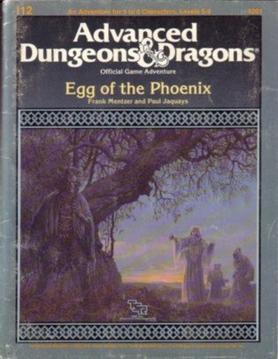
Egg of the Phoenix is an adventure module published in 1987 for the Advanced Dungeons & Dragons fantasy role-playing game.

Dark Tower is an adventure module published by Judges Guild in 1980 for the Advanced Dungeons & Dragons fantasy role-playing game.

Dwarves is a supplement for fantasy role-playing games published by Mayfair Games in 1982, with a second edition published in 1984. It was the fourth Role Aids supplement, and was centered on an adventure and featured background material for using dwarves in role-playing games. It received mixed reviews in game periodicals including The Space Gamer, Different Worlds, and White Dwarf.
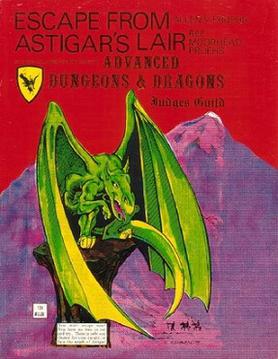
Escape from Astigar's Lair is an adventure for fantasy role-playing games published by Judges Guild in 1980.

Inferno is an adventure for fantasy role-playing games published by Judges Guild in 1980.
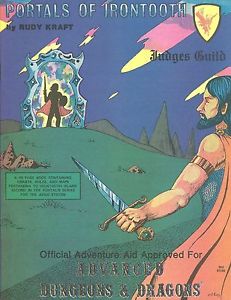
Portals of Irontooth is a supplement for fantasy role-playing games published by Judges Guild in 1981.
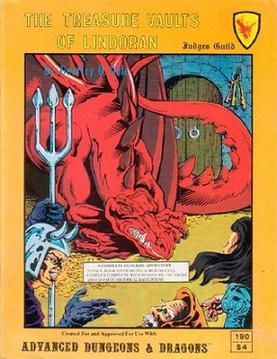
The Treasure Vaults of Lindoran is an adventure for fantasy role-playing games published by Judges Guild in 1980.
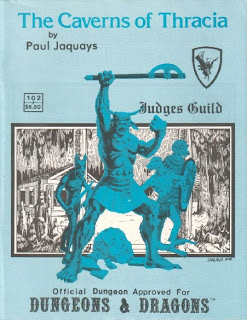
The Caverns of Thracia is an adventure for fantasy role-playing games published by Judges Guild in 1979. Written by Jennell Jaquays, it was compatible with Dungeons & Dragons. A revised edition—compatible with Dungeons & Dragons 3.5 edition—was published in 2004.
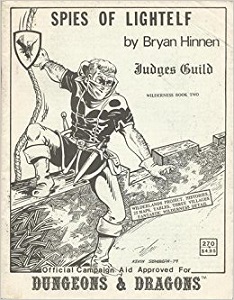
Spies of Lightelf is a supplement for fantasy role-playing games published by Judges Guild in 1980.

Wilderlands of the Fantastic Reaches is a supplement for fantasy role-playing games published by Judges Guild in 1980.
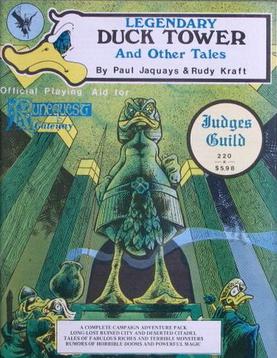
Legendary Duck Tower is a 1980 fantasy role-playing game adventure published by Judges Guild.
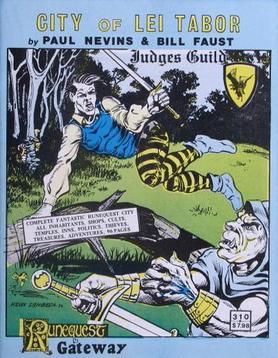
City of Lei Tabor is a 1980 fantasy role-playing game supplement published by Judges Guild for RuneQuest.